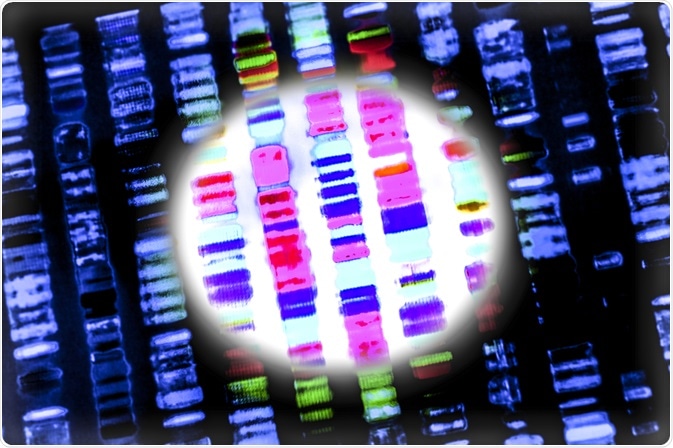Determining the order of nucleic acid residues is integral to many different research applications. Genomics is a rapidly evolving area of scientific research, with recent advances in gene sequencing methodology making the underlying technologies more cost-effective and efficient. Over the last 50 years, subsequent generations have improved upon the previous slew of available technologies.
 Image Credits: Gio.tto / Shutterstock.com
Image Credits: Gio.tto / Shutterstock.com
First-generation methods enabled the sequencing of clonal DNA populations. Second-generation sequencing allowed the necessary throughput and cost-efficiency for sequencing much higher volumes of genomes by parallelizing them, which previously had not been feasible.
Third-generation methods have recently been developed to allow direct sequencing of single DNA molecules. One such third-generation method that has been developed over the last decade is nanopore sequencing.
The technology
There is considerable discussion over what defines third-generation DNA sequencing and how it differs from the second generation. It is argued that the defining characteristics are the possibility of single-molecule sequencing, real-time sequencing, and simple divergence from previous technologies.
Nanopore sequencing is a technique that allows single-molecule sequencing in real-time by passing a DNA sequence of interest through a nanopore. A nanopore is, basically, a very small hole with a diameter on the nanoscale.
Nanopore sequencing is an offshoot of a larger field that uses nanopores for quantification and detection of molecules and biomolecules. The potential of the technology was established even before the advent of second-generation sequencing, where researchers in the field established that single-stranded nucleic acids could be driven across a lipid bilayer through ion channels by using electrophoresis.
Passage through the nanopore by a molecule is detected as a decrease in current for a length of time proportional to the length of the nucleic acid because ion flow is blocked by its passage through the channel.
The technology is able to produce incredibly non-amplified (long read) sequence data at a faster and cheaper rate than previously possible with older technologies, both those from which the method is developed and more contemporary ones.
Commercially available nanopore sequencers and their current applications
The first commercially available nanopore sequencer was developed by Oxford Nanopore Technologies, with their GridION and MinION nanopore platforms being applied to many different research projects and field studies.
MinION is a small, cell phone-sized USB device that was first released in an early access trial in 2014. This device has already shown considerable promise within the field, generating bacterial genome sequences and targeted amplicons. Opportunities exist to decentralize sequencing due to the MinION’s fast run times and compact nature.
They have deployed in the field during Ebola outbreaks, most notably in Guinea, where they were used to sequence a particular strain of Ebola within two days after sample collection, representing a vastly improved quality and speed of analysis that is advantageous during fast-moving disease outbreaks and pandemics.
Though nanopores are most commonly generated through biological means, there is potential for non-biological, solid-state technology generated nanopores. This allows new, unique approaches to exploiting the method.
Expanding on the technology
As with all technologies, researchers are looking at ways to expand the technology of nanopore sequencing. One of the main areas of focus for researchers was how to build bigger pores, which would allow for proteins to be channeled.
One of the potential applications of this development is the creation of viable protein sensors. However, one problem persisted: how to design artificial proteins. There existed a lack of basic knowledge on how to achieve this end.
This challenge led to a new technique for creating artificial nanopores, based on the artificial folding of DNA into complex structures. First explored in the early 21st century, the 3D-origami technique can create contracted artificial nanostructures that mimic and expand on naturally occurring biomolecules.
Writing in Nature Communications in the last few months of 2019, a team of Danish researchers achieved what was previously not possible, representing a paradigm shift in the technology: the creation of large, synthetic nanopores using DNA. This nanopore created by the 3D-origami technique is able to translocate protein-sized macromolecules through the lipid bilayer. A gating system that provided the ability to biosense molecules was also developed.
Other achievements by the researchers were the addition of a controllable plug, which meant that the pore could selectively control the passage of specific molecules by size and the addition of controllable flaps.
The controllable flaps allowed for the insertion of sensors into target membranes that bear specific signal molecules. The research team believes that this could allow for the sensors to be inserted into a diseased cell, opening up possibilities at the cellular level for improvements in diagnosis and treatment of disease that previously were not possible.
A cutting-edge DNA sequencing technology
Certainly, the technology of nanopore sequencing is still relatively new but shows immense promise in the field of DNA sequencing and its application to disease diagnosis, as well as several other areas of life science research.
The technology represents a paradigm shift in the field and is currently the subject of intense development by teams across the world. However, further research is still needed, certainly in the application of the 3D-origami technique, if this cutting-edge technology is to be perfected.
Sources
Heather, J.M and Chain, B (2015) The sequence of sequencer: The history of sequencing DNA Genomics Vol. 107, Issue 1, Pgs. 1 https://www.sciencedirect.com/science/article/pii/S0888754315300410
Thomsen, R.P et al (2019) A large size-selective DNA nanopore with sensing applications Nature Communications 10, Article number: 5655 https://www.nature.com/articles/s41467-019-13284-1
Further Reading
- All DNA Sequencing Content
- DNA Sequencing
- DNA Sequence Assembly
- DNA microarray
- High-throughput DNA Sequencing Techniques
Last Updated: Mar 10, 2020

Written by
Reginald Davey
Reg Davey is a freelance copywriter and editor based in Nottingham in the United Kingdom. Writing for News Medical represents the coming together of various interests and fields he has been interested and involved in over the years, including Microbiology, Biomedical Sciences, and Environmental Science.
Source: Read Full Article
